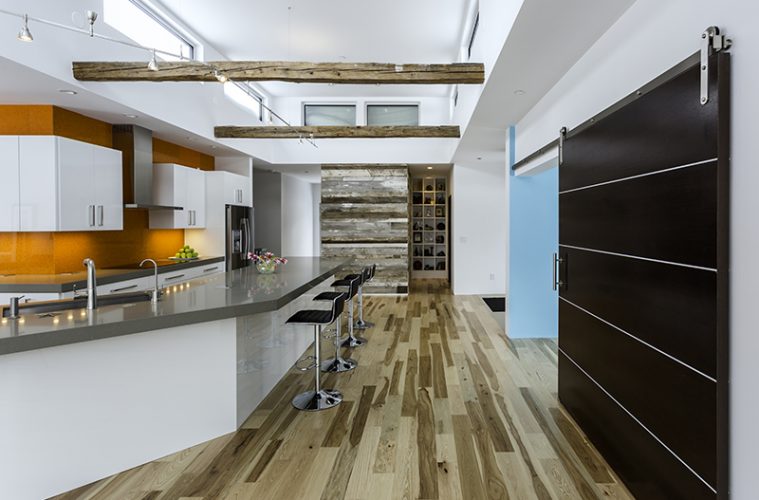Don Bowen is not just an engineer. He is an engineer who is wholly dedicated to using technology to support the environment. He is also an eyewitness to the damage done by the Arab Oil Embargo in the mid-1970s. “Witnessing individuals arguing and fighting in long waiting lines for gasoline left a disturbing impression on me,” Bowen says.
Bowen’s wife, Amy Bowen, shares his dedication to conservation of resources and the natural world. When they brainstormed ideas for their new home in Hamilton, the couple knew whom they wanted as their collaborator: Reading–based architect Steven Baczek. Together the trio found a way to express the Bowens’ dedication to sustainable living: This is a home built on the principles of energy efficiency, nature conservation, and smart living.
The house is a stellar example of how a home can serve an array of environmental purposes and also be beautiful and comfortable. The single-story structure, while ultra-modern, appears as if it grew on the land organically, extending to woods on three sides where deer, fox, and other wildlife find refuge. The tie to the land was high on the couple’s list of priorities. “Both Amy and I felt the home should be constructed in harmony with the beautiful setting and the adjacent woodlands,” says Bowen, the principal of Meridian Associates, Inc., an engineering firm in Beverly.
The first priority for the new house was a net-zero energy requirement (producing as much energy as it uses)—a “non-negotiable” point, Bowen says. The Bowens and Baczek also chose, whenever possible, salvaged or repurposed materials, and new materials with recycled content. Workers, materials, and equipment were locally sourced whenever possible. Another requirement was a low-maintenance house that would be compatible with its gentle pastureland setting.
Baczek embraced the challenge. He has been designing passive-solar and energy-efficient homes countrywide for more than 20 years. Much of his work was as a project architect at Building Science Corporation, a Boston firm that specializes in building-technology research and consulting. “I tell people, ‘Don’t just buy energy efficiency,’” Baczek says. “You want value, [comfortability], and durability. If I build a very durable house with health and comfort [in mind], then I get energy efficiency as a byproduct.” For instance, Baczek saw that by diminishing heating and electric requirements, the photo-voltaic system wouldn’t have to be as massive. (From the sky, the roof’s PV system looks like geometric artwork.)
The home’s modest 2,034-square-foot interior seems much more spacious. Baczek accomplished the bright, airy mood by designing one rectangular space, centered on the kitchen and living area, and several gathering areas. Adjoining the home by way of a shared deck is a small guesthouse that measures 380 square feet.
Throughout the house are natural elements that relate to the region, such as granite, quarried in Rockport more than 100 years ago. Reclaimed wood beautifully reinforces the New England setting and pays homage to the area’s agrarian past. The wall that separates the kitchen from the mudroom is fashioned from reclaimed wood. Reclaimed beams from a Falmouth, Maine, barn run through the kitchen and draw the eye toward the room’s clerestory, with vertical skylights at an airy 13 feet high. The guesthouse features a shining wide-plank reclaimed pumpkin pine floor from a mill in Saco, Maine.
Glass and granite—and the occasional décor item such as the boldly colored rug in the main sitting area—create rich pops of color. The kitchen backsplash, covering almost the entire wall, is stunning orange quartz. In the master bedroom, a rich kiwi-green wall complements the neutral interior. Both of the main house bathrooms are outfitted with green ice-like countertops made by Ray Yaksvachi of Ipswich from 100 percent recycled shower glass doors.
The home’s exterior walls are covered in EcoClad, a resin product of recycled wood fiber and bamboo that gets high points for durability and sustainability. The cladding is hung on the exterior walls, providing a rain screen that, as Baczek says, “gives water a place to go.” Windows are outfitted in high-tech triple-glass by the German company Schüco. All of the home’s power is generated onsite, with U. S.–made solar panels, with emergency electricity provided by Aquion battery technology.
This is a house built on principle. “We felt a compelling obligation to prove to ourselves that building a net-zero energy home with zero emissions was not only our goal but also our responsibility,” Bowen says.
The Bowens’ requirements were music to Baczek’s ears. “Don and Amy came to me with a concept and with honesty,” Baczek says. “If you manage Mother Nature on her principles, you can do good things.”

